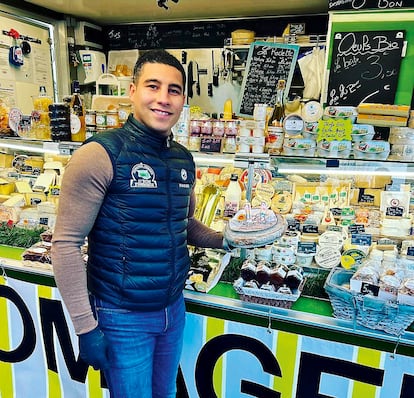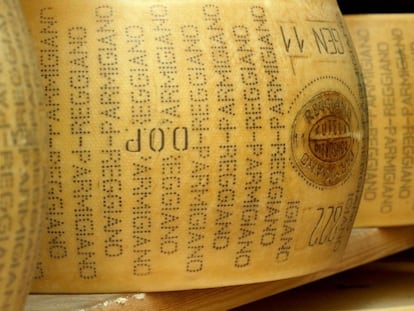How a mobile cheesemonger changed the lives of his neighbors
Nader Baraia, an aeronautical technician turned cheese merchant, energizes the social and commercial life of a French community

The great gastronomic chronicler MFK Fisher once said that wine and cheese are “ageless companions, like aspirin and aches, or June and moon, or good people and noble ventures.” Nader Baraia, a man of Egyptian origin from the Croix Blanche neighborhood of the Vigneux-sur-Seine commune in the southern suburbs of Paris, France, has been an aeronautical technician at Air France, a boxer and now a conceiver of cheese boards, as well as the catalyst of a new market in the neighboring commune of Athis-Mons, next to Orly airport.
Nader — still under 30 years old — saw the light one day when he and his wife went on a trip to Haute-Savoie and discovered the concept of camion-magasin (shop truck). He had seen food trucks, of course, but never a shop on wheels. Driven by the desire to be his own boss and his devotion to French cheeses, he invested every last cent of the €40,000 ($42,180) he had saved, armed himself with paper, pen, and a copy of the Encyclopédie des Fromages - guide illustré de plus de 350 fromages de toutes les régions de France, by Tomoko Yamada (preface by Joël Robuchon), and designed an adventurous project that he called O’Bon Fromage. When his truck and merchandise were ready, he called the mayor and positioned himself one Friday afternoon, alone, in a square in the center of Athis-Mons.
Two years later, Jean-Jacques Grousseau, mayor of Athis-Mons, recalls: “In these districts we have the syndrome of being bedroom communities of the Grand-Couronne in which nothing happens. Our ambition, our commitment, is to energize the environment and promote gatherings. Nader was the first and a few weeks later a fruit seller signed up, then another with fish and later a Lebanese with a delicatessen. Since then, the market has become the Friday afternoon attraction in the center of Athis-Mons.”
Geographer Edward Soja coined the concept of spatial justice in his celebrated essay Seeking Spatial Justice, an invitation to think about the cities and discover how the configuration of public space can be both oppressive and liberating. Spatiality and justice are social constructs that can be modified through political action; Nader’s concept opens the door to recognizing and improving one of those suburbs.
When Nader is asked about the mental strength one needs to enter the cheese arena in such an expert country, he says: “If I weren’t an aeronautical technician I would never have had this mindset, because just like the safety of the flights, we have the obligation to establish hygiene standards for the cheese. When I told my family and friends about my career change, they were scared and concerned. I had a permanent contract at Air France. But I did what I wanted. I refine certain cheeses and work with small producers so that I can always offer my customers something new and, above all, something rare. My favorites — and the three top sellers — are the famous Comté cheese, matured for 18 months and very fruity; Sakura, which in Japanese means ‘cherry leaf,’ a goat cheese briquette with an edible cherry leaf in the center; and Kaltbach mountain cheese.”
Nader is not a traditional shopkeeper; he is a mobile cheesemonger, specialized in suburban markets, aware that the most important thing about a nomadic shop like his is the interrelation it creates with the environment where he sets up and the social fabric that comes together in front of his truck — because, at the end of the day, there is nothing that people like more than good cheese.
Sign up for our weekly newsletter to get more English-language news coverage from EL PAÍS USA Edition
Tu suscripción se está usando en otro dispositivo
¿Quieres añadir otro usuario a tu suscripción?
Si continúas leyendo en este dispositivo, no se podrá leer en el otro.
FlechaTu suscripción se está usando en otro dispositivo y solo puedes acceder a EL PAÍS desde un dispositivo a la vez.
Si quieres compartir tu cuenta, cambia tu suscripción a la modalidad Premium, así podrás añadir otro usuario. Cada uno accederá con su propia cuenta de email, lo que os permitirá personalizar vuestra experiencia en EL PAÍS.
¿Tienes una suscripción de empresa? Accede aquí para contratar más cuentas.
En el caso de no saber quién está usando tu cuenta, te recomendamos cambiar tu contraseña aquí.
Si decides continuar compartiendo tu cuenta, este mensaje se mostrará en tu dispositivo y en el de la otra persona que está usando tu cuenta de forma indefinida, afectando a tu experiencia de lectura. Puedes consultar aquí los términos y condiciones de la suscripción digital.
More information
Últimas noticias
Most viewed
- Sinaloa Cartel war is taking its toll on Los Chapitos
- Oona Chaplin: ‘I told James Cameron that I was living in a treehouse and starting a permaculture project with a friend’
- Reinhard Genzel, Nobel laureate in physics: ‘One-minute videos will never give you the truth’
- Why the price of coffee has skyrocketed: from Brazilian plantations to specialty coffee houses
- Silver prices are going crazy: This is what’s fueling the rally











































